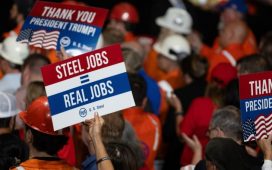Consumer spending slowed and the Federal Reserve’s preferred inflation gauge continued to moderate in May, the latest signs that the cool-down that policymakers have been aiming for is materializing — albeit more haltingly than they might prefer.
U.S. consumers spent just 0.1 percent more in May than the month before, the Commerce Department said on Friday. That was down from 0.6 percent growth in April, which was itself weaker than previously reported. Adjusted for inflation, spending in May was flat.
Slower spending may sound like bad news: Consumption is, after all, the engine of economic growth in America. But Fed officials have been raising interest rates to try to restrain consumer and business demand, hoping that such a weakening will force companies to stop raising prices so quickly. That could allow inflation, which has been rapid for more than two years, to return to a normal pace.
For now, price increases are moderating but remain more stubborn than Fed officials might prefer. Overall inflation cooled to 3.8 percent in the year through May, Friday’s report showed, the first time it has slipped below 4 percent since early 2021. But a “core” inflation measure that stripped out food and fuel costs — which move around a lot — remained stubbornly high. Officials closely watch that measure for a sense of how quickly prices will increase in the months and years ahead.
While core inflation moderated to 4.6 percent in May, a softer reading than the 4.7 percent economists had forecast, it has hovered right around that pace since December.
“It’s progress,” Omair Sharif, the founder of Inflation Insights, said of the report as a whole. “But things are still just way too high.”
More modest overall inflation is taking some pressure off consumers: Cheaper tanks of gas and less rapid price increases in the grocery aisle are helping paychecks go further. But for officials at the Fed, signs that inflation remains stubborn under the surface have been a reason to worry. Officials believe that they need to wrestle core price increases lower to make sure that the economy’s future is one of modest and steady price increases.
Fed policymakers have been raising interest rates since March 2022 in a bid to cool the economy and bring inflation back under control, and they have projected that they will raise them slightly more in 2023. Making it more expensive to get a home loan or expand a business can drag on economic momentum.
But a range of recent data points have suggested that the Fed’s moves are so far failing to fully sap the economy of its steam. The housing market weakened sharply last year, but it has shown signs it is beginning to recover. Growth was faster than previously believed early this year, data this week showed. People are still buying cars, taking vacations and eating out, based on a range of real-time data trackers.
In fact, Kathy Bostjancic, chief economist at Nationwide, cautioned against reading too much into the slowdown in consumer spending in the fresh May data. She thought that some of the pullback was probably owed to a limited supply of cars, which prevented more auto sales.
Still, she said the report was marginally good news for policymakers. The fact that April spending was weaker than the strong uptick previously reported was probably a welcome development.
“It is better than the alternative,” Ms. Bostjancic said.
And the report contained subtle but important hints that consumers are becoming more cautious. After months of drawing down savings amid rising prices, Americans have begun saving more, which historically has been a sign of worries about the economy.
“Consumers are saving more and spending less, perhaps out of caution as most believe a recession is either here or imminent,” Robert Frick, corporate economist with Navy Federal Credit Union, wrote in a note to clients.
That could help make the Fed more comfortable that rates are high enough — or nearly high enough — to restrain the economy and bring inflation back to target over time.
Policymakers have raised interest rates to 5 percent, but they skipped a rate increase at their June meeting, after 10 straight moves, to give themselves time to assess how much more would be needed. Officials forecast that they could lift rates to 5.5 percent by the end of the year.
Investors had been betting on only one more quarter-point move this year, but they have in recent days nudged up the chances of two moves before the end of 2023. Those odds fell slightly after Friday’s report. Markets broadly welcomed the fresh data, helping to push the S&P 500 stock index more than 1 percent higher on Friday morning.
Ms. Bostjancic said she believed that the Fed would most likely raise interest rates in July still but that Friday’s consumer spending data could — at least at the margin — “ease the pressure” for further changes beyond that.
Jerome H. Powell, the Fed chair, emphasized this week at an event in Madrid that the outlook for how much more rates might move this year was uncertain.
Inflation has consistently been “more persistent and stronger than expected,” Mr. Powell said. “At some point, that may change. And I think we have to be ready to follow the data and be a little patient as we let this unfold.”
Joe Rennison contributed reporting.







